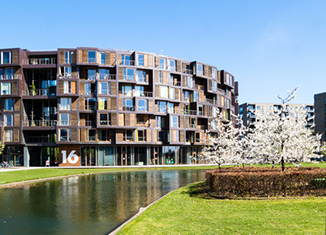A new report by Catella has assessed the student housing sector across Europe. Due to steadily increasing student numbers and the widespread undersupply of affordable student accommodation, the European student housing asset class has been a growing investment market in the last few years. Despite the changes and adaptations in student life due to the COVID-19 pandemic - online courses, travel restrictions, postponement of semester dates and deadlines, etc. - the European student housing market has proved itself largely resilient in the crisis: the demand for student accommodation did not decreased significantly in 2020 and the willingness to invest has remained stable compared to the previous year, according to the report, a summary of which is below.
Student housing before the pandemic – The number of students worldwide has been growing steadily in the last few years. In particular, the share of international students has increased significantly in the last decade, with the highest increase of international students from China and India.
A consequence of this increased international student mobility has been higher demand for student accommodation and a growing student housing market. Globally, the investment volume in student housing increased by 135% between 2014 and 2019, with the USA and the UK the most popular countries for international students, due to the large number of internationally renowned universities.
 Student housing during the pandemic – With the outbreak of the pandemic, higher education institutions had to close their campuses, resulting in a change to online education. On the one hand, in some cases international students were unable to return to their home countries and stayed in their student accommodation. However, on the other hand, there were fewer international students coming to Europe for the academic year 2020/21.
Student housing during the pandemic – With the outbreak of the pandemic, higher education institutions had to close their campuses, resulting in a change to online education. On the one hand, in some cases international students were unable to return to their home countries and stayed in their student accommodation. However, on the other hand, there were fewer international students coming to Europe for the academic year 2020/21.
Student mobility decreased significantly and countries that depend more on international students were more negatively affected. Due to travel restrictions and the increased risk of infection, some international students have postponed their start at university, says Catella. However, especially in Europe, more high school graduates achieved a university entrance qualification last year than in previous years.
Student accommodation occupancy rates declined a little in 2020 and for Europe as a whole it fell by around 10%. Due to travel restrictions, occupancy in the UK dropped sharply, while other countries, such as France and Spain, experienced less of an impact - the Studierendenwerk in Germany reported in July 2020 an occupancy level of 90-95%.
The report found that cities with an undersupply of student accommodation proved resilient during the crisis, but added that the true impact of the pandemic on student numbers is not yet measurable. However, Catella did not that due to the uncertain labour market situation, students are more likely to choose to study as an alternative, or study longer in order to postpone their entry into the world of work.
The housing situation for students in Europe – Living either with parents or in shared accommodation are still the most common living situations for students in Europe. On average, only 17% of all students in Europe live in student accommodation (PBSA) and another 10% live alone.
However, in the Nordics (Finland, Sweden, Denmark, and Norway), the proportion of students living with their parents is very low and the proportion of students living in student accommodation is above the European average. There are many reasons for the different housing situations of students: cultural, traditional, and institutional factors, housing availability and prices, differences in terms of income, employment, parental support, and the respective family situation.
Transactions in Europe – The UK is the market leader in Europe when it comes to student housing transactions (96,000 beds in the past two years) compared to France (9,000 beds), Germany (6,100) and Spain (approx. 5,700).
Student housing requirements and how they have changed since the pandemic – Catella says that students are looking for a fast and stable internet connection (for streaming online classes), sufficient space in the study and common rooms, single rooms, a higher frequency of cleaning and disinfection measures of the rooms and the introduction of general infection control and safety measures.
At the conclusion of the report, Catella listed the pros of investing in student housing in Europe, which included the fact that the markets in Europe are largely undersupplied, the trend towards a sharing society and on-campus living, a predictable income stream due to semester or yearly lease terms, diversified revenue models (additional services), the Europe-wide increase in the supply of ETP (English Taught Programmes), and the steady growth of international students.
Regarding the cons of investing in student housing in Europe, the report cited the high tenant turnover and, depending on the concept, vacancies during the semester break or the summer. It also noted the higher share of rent that needs to be paid to the management company, the risk that the operator is not efficient, increasing competition, and the inflation of construction and property costs.




















